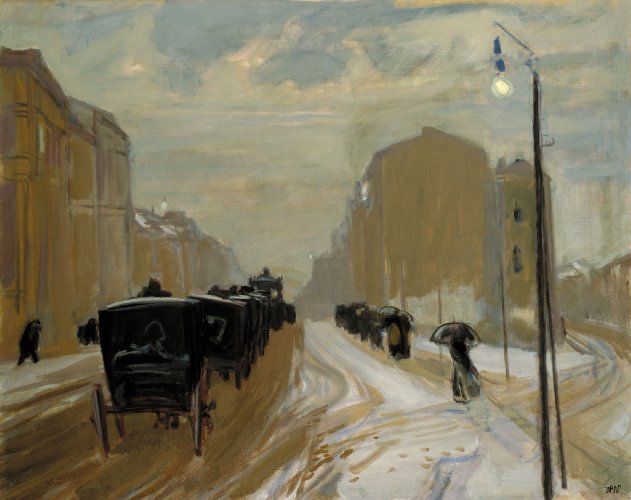Description:
Wojciech Weiss (1875-1950) was born in Romania, from where in 1888 he moved to Poland with his parents. After finishing the Krakow Gymnasium he began his studies at the School of Fine Arts. Numerous European trips allowed the artist to become acquainted with contemporary artistic trends, which can be found in his works. At the age of only 23, he made his debut at the exhibition of the Warsaw Society for the Encouragement of Fine Arts. Recognized as a promising talent, he was a member of the Polish Artists Society “Sztuka” a year later. For years he regularly exhibited his paintings, winning numerous awards. In his work, one can distinguish different stylistic periods. The first, referred to as expressionist, imbued with symbolism, was characterized by works inspired by the works of Edward Munch. Paintings painted in a dark palette were full of unrest and pessimism. The next – the white period – takes its name from the artist’s search for light. The works of this period, painted in a bright colour scheme, are full of joy of life. Towards the end of his life, he focused on the trend of socialist realism, adapting to the realities of the time.
Description of the painting:
The painting by Weiss transports us to a winter scene of an unnamed city. In the middle of a wide, muddy street, a majestic carriage can be seen in the distance, from which a procession of black coaches slowly rolls along. Accompanied by silhouettes of people walking along the sides, crouched under umbrellas, mourners. The sadness of the funeral procession and the wet, twilight atmosphere are accompanied by black holes, synthetically characterized by tenements. They are not able to revive the faint light of the gas lamps visible here and there. Marking the retreating line of roofs and accompanying the flaming coach lamps, they illuminate the last journey of the deceased. The most prominently placed, standing alone in the foreground, completes and closes this perfect, diagonal-cross composition. At the same time, its expressive light and black pillar correspond to the centrally placed carriage. It also separates the extreme parts of the pictorial field, preventing the intolerable symmetry of the whole, balanced by the view of the side, empty street.
The artist used almost a monochromatic palette. It consists of the dirty grays of the urban landscape and muted blues of the sky covered with heavy clouds. Against this background, the dominating black of the funeral procession and the white of the melting, touched by blue snow stand out particularly.
This work, of first-rate importance for Polish modernism, reflects the tradition of city nocturnes filled with a sense of alienation and sadness by Gierymski and Pankiewicz, and the sensitivity to the problem of light and colour acquired from the Wyczółkowski studio. The influence of the then very popular Japanese art, which emphasizes the significance of emptiness as an essential “positive” means of expression, is also noticeable here.
The influence of the expressionistic art of Edward Munch, which was introduced to him by Stanisław Przybyszewski, can also be seen. At this early stage of his work, he also accepted Przybyszewski’s catastrophic and Manichean vision of the world. It was particularly felt in the decadent atmosphere of the big city, identified with this satanic, full of the vision of death “metropolis”, or “as Przybyszewski put it, interpreting Munch – hostile to human nature”.
In it, the funeral scene becomes almost an emotionless “social phenomenon that has nothing to do with the afterlife”. In the world of predatory capitalism and growing skepticism, the lofty poetry of death was replaced by a feeling of confusion and hopelessness. Using the characterization of the “Peasant’s Coffin” painted by Aleksander Gierymski a few years earlier, one could say that: “Everything that was heroic, morally uplifting, picturesque, Arcadian, mystical and supernatural in the iconography of death, cemetery and funeral has passed away. What remains is human despair, which, intensified by the artist’s artistic means, giving it symbolic power, becomes a kind of silent complaint about the completely earthly human plight. ”** The place of realistic representation was already taken by the “Munch” deformation, incorporating Weiss’s work in the circle of symbolizing expressionism.
On the other hand, the “monochromatism of the colour range” “places it [..] on the subtle border of transition from the first phase of the artist’s modernist art to the next, the so-called white period of his painting”. A period announcing his mature work in the post-impressionist colourist trend and “Arcadian vision of the world, imbued with admiration for the beauty of nature” **.
The number of paintings we find in the Rogaliński Gallery from this time suggests that it must have been particularly close to Edward A. Raczyński. However, together with them, he acquired the discussed earlier painting, which is located between the Courbet’s realistic “Funeral in Ornans”, which was admired by Weiss in Paris, and the “Funeral of a Strike Participant” by Stanisław Fabjański from 1907, which is an example of a fighting art.
An open question remains whether this was decided only by the outstanding painting value of the “Funeral” or the readable in it Manichean, dualistic vision of the world, which takes two opposing elements as the principle of being: light and goodness, and darkness and evil. On the other hand, the symbolism of the square as a perfect figure associated with the inevitable death, but also the heavenly Jerusalem, concealed in the painting.


